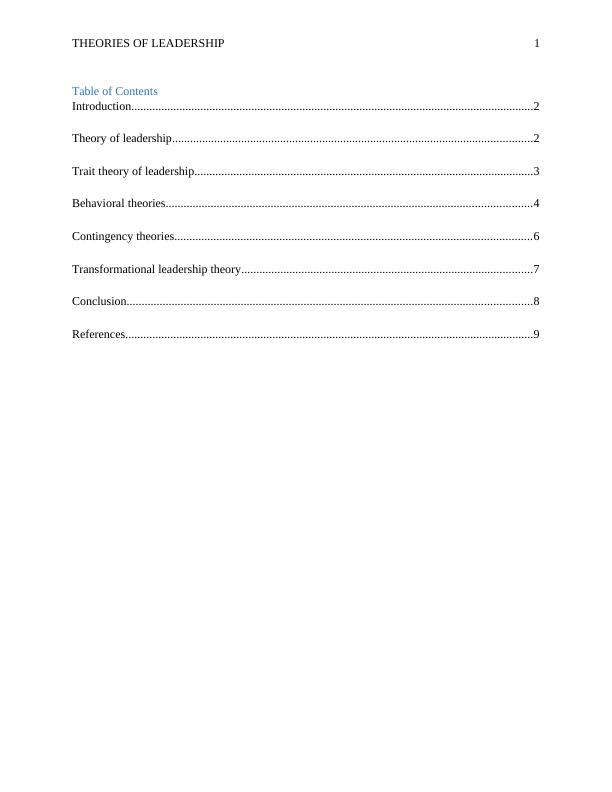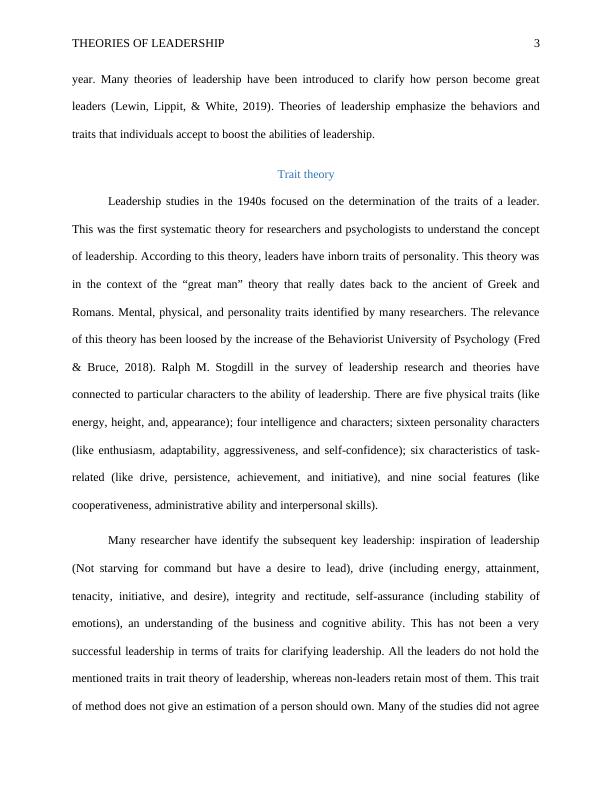Theories of Leadership
Added on 2022-11-25
11 Pages2419 Words212 Views
THEORIES OF
LEADERSHIP
Running Head: THEORIES OF LEADERSHIP 0
LEADERSHIP
Running Head: THEORIES OF LEADERSHIP 0

THEORIES OF LEADERSHIP 1
Table of Contents
Introduction......................................................................................................................................2
Theory of leadership........................................................................................................................2
Trait theory of leadership.................................................................................................................3
Behavioral theories..........................................................................................................................4
Contingency theories.......................................................................................................................6
Transformational leadership theory.................................................................................................7
Conclusion.......................................................................................................................................8
References........................................................................................................................................9
Table of Contents
Introduction......................................................................................................................................2
Theory of leadership........................................................................................................................2
Trait theory of leadership.................................................................................................................3
Behavioral theories..........................................................................................................................4
Contingency theories.......................................................................................................................6
Transformational leadership theory.................................................................................................7
Conclusion.......................................................................................................................................8
References........................................................................................................................................9

THEORIES OF LEADERSHIP 2
Introduction
Motivating and influencing people is the art of leaders to perform in a manner to
accomplish a common goal. The leadership is constituted by the total of a leader's tasks, roles,
responsibilities, and interpersonal influences (Yukl, 2010). The leader should possess the high
character and integrity, means of rightly doing, concerned with doing the right things with ends,
and with the general capacity of solving the problem. The success of a team is crucial for a
leader. Many research has been conducted and a substantial amount of research has been done to
find how a leader become effective (Hersey, 2016). This is the process that executes guide,
direct, and affects the work and conduct of others for achieving the particular goals. This is the
aptitude of a leader to subordinate the work with confidence (Bass, 2015). The behaviors of
others are the potential to influence leadership. Keith Davis refers that “Leadership is the ability
to persuade others to seek defined objectives enthusiastically. It is the factor of human that binds
a group together and motivates towards goals.” Leadership theories with appraising current
exploration on the applicability and evolution for theories of leadership have been covered under
the following theories.
Leadership theories
Theories of leadership are categorized by aspects that believed to define the leader.
Theories of the leadership evaluate the effectiveness of leaders to convince partners, lenders,
employees, vendors, and customers to follow the pursuit of a vision. Theories of leadership help
leaders to approach the style of leadership. Leaders are essential for the development of visions
of the future and to motivate the members of the organization to achieve the missions and
visions. Effective leaders have to communicate with people and work ceaselessly to motivate
people in an efficient manner. An attention of leadership psychology has improved over the last
Introduction
Motivating and influencing people is the art of leaders to perform in a manner to
accomplish a common goal. The leadership is constituted by the total of a leader's tasks, roles,
responsibilities, and interpersonal influences (Yukl, 2010). The leader should possess the high
character and integrity, means of rightly doing, concerned with doing the right things with ends,
and with the general capacity of solving the problem. The success of a team is crucial for a
leader. Many research has been conducted and a substantial amount of research has been done to
find how a leader become effective (Hersey, 2016). This is the process that executes guide,
direct, and affects the work and conduct of others for achieving the particular goals. This is the
aptitude of a leader to subordinate the work with confidence (Bass, 2015). The behaviors of
others are the potential to influence leadership. Keith Davis refers that “Leadership is the ability
to persuade others to seek defined objectives enthusiastically. It is the factor of human that binds
a group together and motivates towards goals.” Leadership theories with appraising current
exploration on the applicability and evolution for theories of leadership have been covered under
the following theories.
Leadership theories
Theories of leadership are categorized by aspects that believed to define the leader.
Theories of the leadership evaluate the effectiveness of leaders to convince partners, lenders,
employees, vendors, and customers to follow the pursuit of a vision. Theories of leadership help
leaders to approach the style of leadership. Leaders are essential for the development of visions
of the future and to motivate the members of the organization to achieve the missions and
visions. Effective leaders have to communicate with people and work ceaselessly to motivate
people in an efficient manner. An attention of leadership psychology has improved over the last

THEORIES OF LEADERSHIP 3
year. Many theories of leadership have been introduced to clarify how person become great
leaders (Lewin, Lippit, & White, 2019). Theories of leadership emphasize the behaviors and
traits that individuals accept to boost the abilities of leadership.
Trait theory
Leadership studies in the 1940s focused on the determination of the traits of a leader.
This was the first systematic theory for researchers and psychologists to understand the concept
of leadership. According to this theory, leaders have inborn traits of personality. This theory was
in the context of the “great man” theory that really dates back to the ancient of Greek and
Romans. Mental, physical, and personality traits identified by many researchers. The relevance
of this theory has been loosed by the increase of the Behaviorist University of Psychology (Fred
& Bruce, 2018). Ralph M. Stogdill in the survey of leadership research and theories have
connected to particular characters to the ability of leadership. There are five physical traits (like
energy, height, and, appearance); four intelligence and characters; sixteen personality characters
(like enthusiasm, adaptability, aggressiveness, and self-confidence); six characteristics of task-
related (like drive, persistence, achievement, and initiative), and nine social features (like
cooperativeness, administrative ability and interpersonal skills).
Many researcher have identify the subsequent key leadership: inspiration of leadership
(Not starving for command but have a desire to lead), drive (including energy, attainment,
tenacity, initiative, and desire), integrity and rectitude, self-assurance (including stability of
emotions), an understanding of the business and cognitive ability. This has not been a very
successful leadership in terms of traits for clarifying leadership. All the leaders do not hold the
mentioned traits in trait theory of leadership, whereas non-leaders retain most of them. This trait
of method does not give an estimation of a person should own. Many of the studies did not agree
year. Many theories of leadership have been introduced to clarify how person become great
leaders (Lewin, Lippit, & White, 2019). Theories of leadership emphasize the behaviors and
traits that individuals accept to boost the abilities of leadership.
Trait theory
Leadership studies in the 1940s focused on the determination of the traits of a leader.
This was the first systematic theory for researchers and psychologists to understand the concept
of leadership. According to this theory, leaders have inborn traits of personality. This theory was
in the context of the “great man” theory that really dates back to the ancient of Greek and
Romans. Mental, physical, and personality traits identified by many researchers. The relevance
of this theory has been loosed by the increase of the Behaviorist University of Psychology (Fred
& Bruce, 2018). Ralph M. Stogdill in the survey of leadership research and theories have
connected to particular characters to the ability of leadership. There are five physical traits (like
energy, height, and, appearance); four intelligence and characters; sixteen personality characters
(like enthusiasm, adaptability, aggressiveness, and self-confidence); six characteristics of task-
related (like drive, persistence, achievement, and initiative), and nine social features (like
cooperativeness, administrative ability and interpersonal skills).
Many researcher have identify the subsequent key leadership: inspiration of leadership
(Not starving for command but have a desire to lead), drive (including energy, attainment,
tenacity, initiative, and desire), integrity and rectitude, self-assurance (including stability of
emotions), an understanding of the business and cognitive ability. This has not been a very
successful leadership in terms of traits for clarifying leadership. All the leaders do not hold the
mentioned traits in trait theory of leadership, whereas non-leaders retain most of them. This trait
of method does not give an estimation of a person should own. Many of the studies did not agree

End of preview
Want to access all the pages? Upload your documents or become a member.
Related Documents
Leadership Theorieslg...
|5
|1056
|51
Leadership Theorieslg...
|5
|1050
|22
Understanding leadership effectiveness assignment (pdf)lg...
|11
|2581
|18
Theories of Leadership - Essaylg...
|12
|3015
|92
Theories of Leadership: Reviewing Current Research on Evolution and Applicabilitylg...
|11
|3128
|447
Leadership Research Paper 2022lg...
|14
|3889
|30
